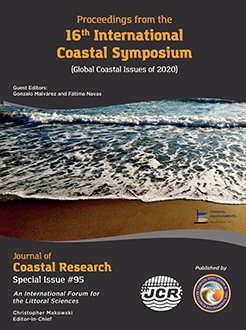Brayne, R.P.; Lorang, M.S.; Naylor, L.A., and Reinhardt, L., 2020. Field-based observation of the entrainment threshold of cobbles with motion loggers. In: Malvárez, G. and Navas, F. (eds.), Global Coastal Issues of 2020. Journal of Coastal Research, Special Issue No. 95, pp. 392–397. Coconut Creek (Florida), ISSN 0749-0208.
Beaches composed of pebble to boulder-sized material are a common feature of coastal regions and provide effective protection against wave attack. The wave-related entrainment threshold of these coarse particles is of utmost importance to defining the onset of dynamic beach behavior. Wave-competence equations derived to predict the boundary between particle stability and entrainment when acted on by waves (e.g. Lorang, 2000) are useful when designing artificial gravel beaches as shore protection structures because they help inform the size of material required to mimic the dynamic behavior of their natural counterpart. The objective of this study is to use motion loggers embedded within native cobbles to measure the entrainment threshold during storm wave events to provide much-needed field data with which to test the accuracy of the Lorang (2000) equations. The movement of 14 cobbles were observed over a range of conditions (0.10 m < HS < 0.52 m) during five separate 1.5-hour-long experiments on coarse pebble/cobble beach at Flathead Lake, Montana, USA. The entrainment threshold was positively related to wave power and was accurately predicted by the Lorang (2000) equations using significant wave height, mean period and beach slope to estimate swash velocities and run-up height as driving variables. More experiments are required to constrain the value(s) used for the beach stability coefficient Kr, although the values found here correspond with the widely used Hudson Formula (Hudson, 1952). Alternatively, directly quantifying swash velocities and run-up elevations from video analysis would greatly improve the results rather than estimating these primary variables. These results provide a unique insight into the wave-competence approach to designing dynamic revetments and artificial gravel beaches as shore protection alternatives to rip-rap and seawalls at a time when rising sea level and a potential increase in storm intensity are likely to increase the wave impact on coastal regions.





